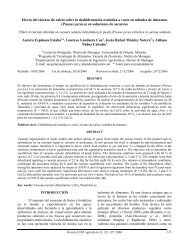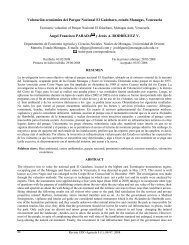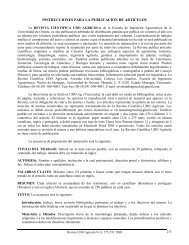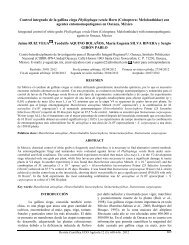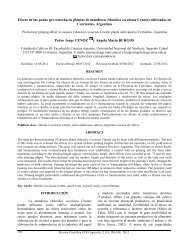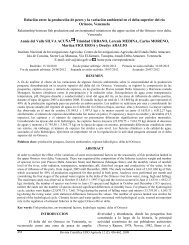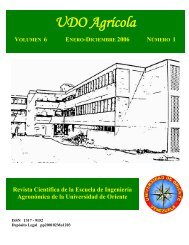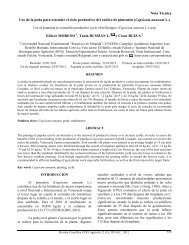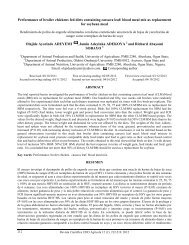(Download all Papers) (PDF) - UDO AgrÃcola
(Download all Papers) (PDF) - UDO AgrÃcola
(Download all Papers) (PDF) - UDO AgrÃcola
You also want an ePaper? Increase the reach of your titles
YUMPU automatically turns print PDFs into web optimized ePapers that Google loves.
Jabeen et al. Character association in Chilli (Capsicum annuum L.)<br />
oleoresin. It is native of South America, and though<br />
origin<strong>all</strong>y of tropical origin, can grow in cooler<br />
climates also. In India, the available Paprika types are<br />
not suitable for cultivation in <strong>all</strong> chilli growing areas<br />
(Prasath and Ponnuswami, 2008). Therefore, there is<br />
an urgent need to develop location specific cultivars<br />
for enhanced adaptability and productivity.<br />
Since yield is a complex trait, governed by a<br />
large number of component traits, it is imperative to<br />
know the interrelationship between yield and its<br />
component traits to arrive at an optimal selection<br />
index for improvement of yield. Wright (1921) was<br />
first to propose the correlation and path analysis to<br />
organize the relationship between predictor variables<br />
and the response variable. Correlation simply<br />
measures the association between yield and other<br />
traits, while as path coefficient analysis permits the<br />
separation of correlation into direct effects (path<br />
coefficient) and indirect effects (effects exerted<br />
through other variables). It is basic<strong>all</strong>y a standardized<br />
partial regression and deals with the closed set of<br />
variables which are linearly related. Such an analysis<br />
provides for realistic basis of <strong>all</strong>ocation of appropriate<br />
weightage to various yield components. Since not<br />
many studies have been conducted in case of paprika,<br />
the present study was undertaken to study the<br />
association of various yield attributing traits to<br />
develop a reliable set of traits for indirect selection.<br />
MATERIALS AND METHODS<br />
The present investigation was carried out in<br />
2007-2008 at Vegetable Research Farm of SKUAST-<br />
K, Shalimar. The material consisted of 25 chilli<br />
genotypes namely P-2, P-4, P-7, P-9, P-19, P-20, P-<br />
29, P-37, P-59, P-101, P-104, P-201, P-444, P-1005,<br />
PL-7, LCA-436, LCA-443, KTPL-19, ACS-2001-01,<br />
ACS-2001-04, Arka Abhir, Bayadagi Dabbi, IVPBC-<br />
535, IVPBC-553 and Bayadagi Kaddi. Each entry<br />
was represented by two replications in a randomized<br />
block design with a spacing of 60 x 40 cm.<br />
Recommended package of practices was adopted to<br />
raise a good crop. The data was observed from five<br />
randomly selected competitive plants from each<br />
replication for eight quantitative traits viz, plant<br />
height (cm), plant spread (cm), number of<br />
branches/plant, number of fruits/plant, average fruit<br />
weight (g), fruit length (cm), fruit breadth (cm), and<br />
fruit yield/plant (g). The data was statistic<strong>all</strong>y<br />
analyzed following Aljibouri et al (1958) for<br />
estimation of correlation coefficient, while as path<br />
analysis was done by method of Dewey and Lu<br />
(1959).<br />
RESULTS AND DISCUSSION<br />
The results of correlation coefficients are<br />
presented in Table 1, which revealed that genotypic<br />
Table 1. Genotypic (above diagonal) and phenotypic (below diagonal) correlation coefficients for eight quantitative traits in<br />
chilli (Capsicum annuum L.).<br />
Trait<br />
Plant<br />
height<br />
Plant<br />
spread<br />
Number of<br />
branches/plant<br />
Number of<br />
fruits/plant<br />
Average fruit<br />
weight<br />
Fruit<br />
length<br />
Fruit<br />
breadth<br />
Fruit yield/<br />
plant<br />
Plant<br />
height<br />
(cm)<br />
Plant<br />
spread<br />
(cm)<br />
Number of<br />
branches/<br />
plant<br />
Number of Average<br />
fruits/plant fruit weight<br />
(g)<br />
Fruit<br />
length<br />
(cm)<br />
Fruit<br />
breadth<br />
(cm)<br />
Fruit yield/<br />
plant<br />
(g)<br />
1.000 0.093 0.311** 0.379** -0.191 0.201 -0.108 0.286**<br />
0.087 1.000 -0.277* -0.130 0.004 -0.088 -0.098 -0.152<br />
0.272* -0.263 1.000 0.478** 0.117 -0.083 -0.137 0.449**<br />
0.368** -0.089 0.468** 1.000 -0.076 -0.348** -0.061 0.557**<br />
-0.159 0.002 0.109 -0.070 1.000 0.207 0.296** 0.219<br />
0.189 -0.073 -0.076 -0.344** 0.199 1.000 -0.133 -0.143<br />
-0.093 -0.089 -0.133 -0.049 0.293** -0.122 1.000 0.233<br />
0.468** -0.138 0.446** 0.551** 0.214 -0.135 0.214 1.000<br />
** Significant (p ≤ 0.01) and * Significant (p ≤ 0.05)<br />
488<br />
Revista <strong>UDO</strong> Agrícola 9 (3): 487-490. 2009



